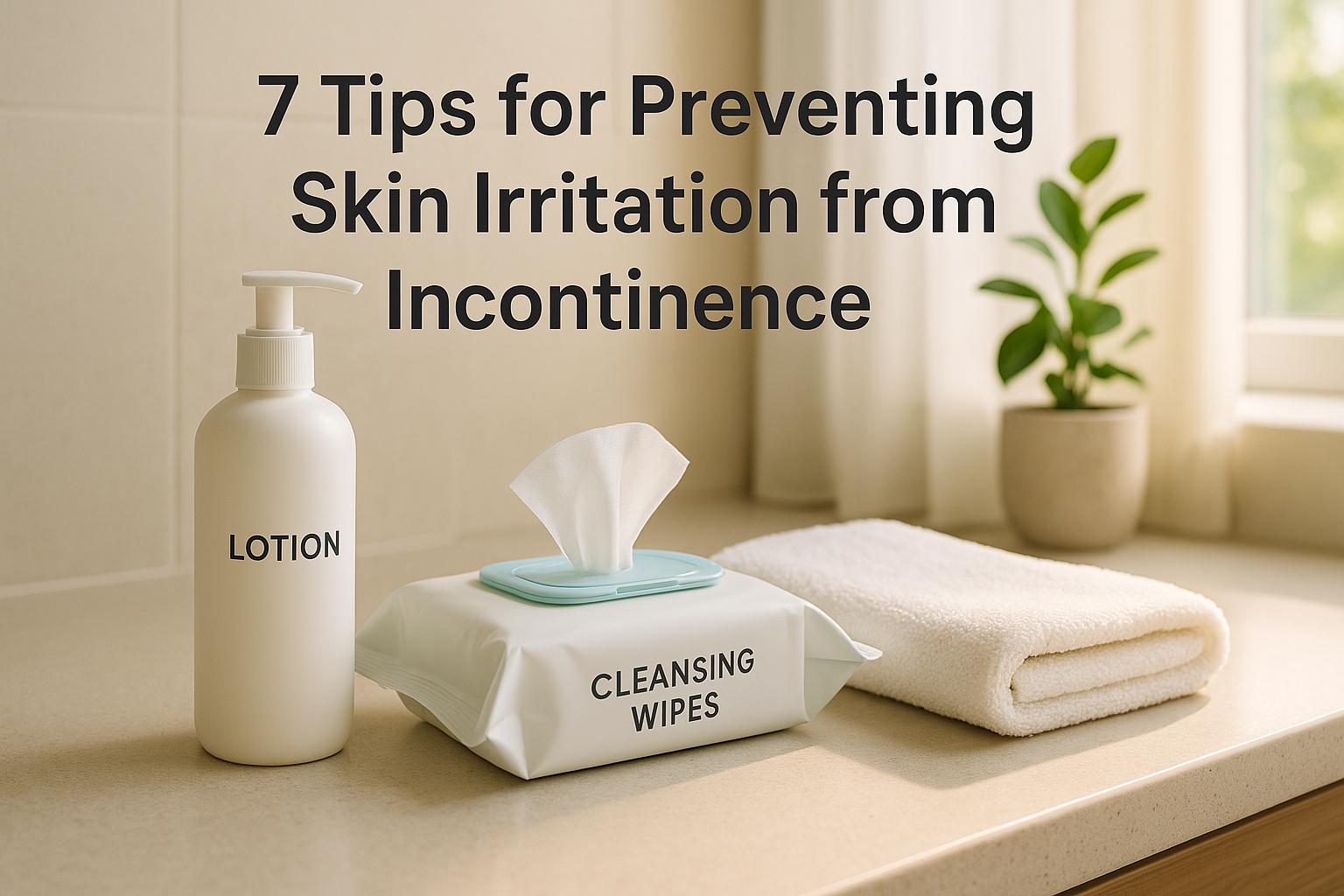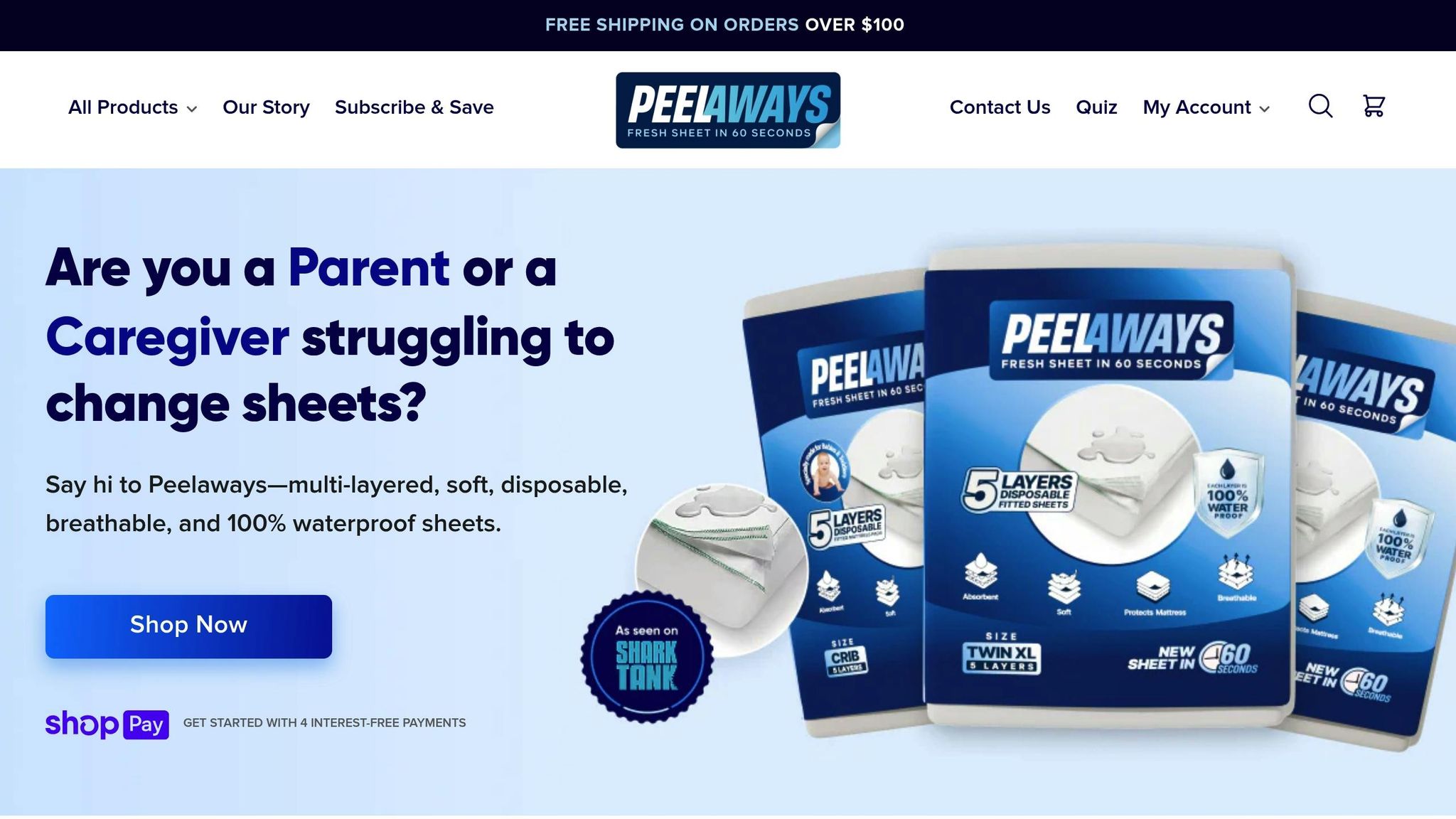7 Tips for Preventing Skin Irritation from Incontinence

Skin irritation caused by incontinence is preventable with the right care. Prolonged exposure to moisture, friction, and irritants like urine or fecal matter can harm the skin, but simple steps can help protect it. Here’s how:
- Change incontinence products frequently to avoid moisture buildup.
- Clean skin gently with mild, fragrance-free cleansers after every episode.
- Thoroughly dry the skin to prevent bacterial growth.
- Use barrier creams to shield the skin from irritants.
- Opt for moisture-absorbing bedding to maintain dryness and reduce laundry.
- Inspect skin daily to catch redness or irritation early.
- Support overall skin health through hydration, a balanced diet, and breathable clothing.
These steps, combined with tools like multi-layer disposable bedding (e.g., PeelAways), make managing incontinence easier while reducing discomfort and risks. Early action and consistent care are key to maintaining healthy skin.
Incontinence Associated Dermatitis
What Causes Skin Irritation from Incontinence
Understanding what leads to incontinence-related skin irritation is key to preventing it before it becomes a problem. Several factors come into play, each contributing to skin breakdown in different ways.
Prolonged moisture exposure is one of the biggest culprits. When the skin is exposed to moisture for extended periods, its natural barrier softens, making it easier for irritants and bacteria to reach deeper layers.
Chemical irritation is another major issue. Urine contains ammonia and other compounds that, over time, create an alkaline environment, disrupting the skin's natural pH balance. Fecal matter introduces digestive enzymes that break down skin tissue in much the same way they break down food in the digestive system.
Friction and mechanical damage happen when wet skin rubs against surfaces. Damp skin is far more vulnerable - up to five times more likely to tear or suffer abrasions than dry skin. Even small movements can cause tiny tears in already weakened skin.
Temperature and humidity add another layer of complexity. Trapped body heat increases moisture levels and speeds up bacterial growth, creating the perfect conditions for further irritation. These environmental factors make the situation worse, especially for those who are already at risk.
Certain groups are more vulnerable to these issues. Elderly individuals have thinner, more delicate skin that heals slowly and is prone to tearing. With age, the skin produces less natural oil, becoming drier and less able to resist irritation.
Immobile patients face unique challenges as they cannot shift positions to relieve pressure or prevent moisture buildup. They rely entirely on caregivers for hygiene and care, making consistent routines essential.
Individuals with diabetes are also at higher risk due to slower healing and an increased likelihood of infections caused by poor circulation and reduced immune function.
People with cognitive impairments may not recognize or communicate discomfort. They might also resist care, making it harder to ensure proper cleaning and skin assessments.
These combined factors explain why incontinence-associated dermatitis can develop so quickly and why prevention requires such close attention to detail and care.
7 Tips for Preventing Skin Irritation
Preventing skin irritation involves taking proactive steps to address the factors that can lead to skin breakdown. These seven practical strategies can help caregivers maintain healthy skin and reduce the risk of complications.
Change Incontinence Products Quickly
Changing incontinence products promptly is essential to prevent rashes, urinary tract infections (UTIs), and skin breakdown.
"Like all incontinence supplies, you should change your bladder control pad when you have an accident to prevent issues like: Rashes and redness. Urinary tract infections (UTIs). Chafing Skin breakdown." – Aeroflow Urology [1]
Even if there’s no visible leakage, products should be replaced every three to four hours. Many products can trap moisture from sweat or small amounts of urine, creating an environment where bacteria thrive. TENA suggests changing pads 3–5 times daily, though individual needs may vary depending on factors like skin sensitivity, leakage levels, and product type [2].
For nighttime, use high-absorbency products designed for extended wear, and always replace them in the morning if they’ve been soiled. Those with heavier incontinence or active routines might require more frequent changes throughout the day.
Clean Skin Gently and Often
After each incontinence episode, clean the skin gently with lukewarm water and a mild, fragrance-free cleanser. Regular soaps can disrupt the skin’s natural pH balance, so avoid them.
Pat the skin dry instead of rubbing it, as moist skin is more susceptible to irritation. Pay extra attention to folds and creases where moisture and bacteria tend to gather. If mobility is limited, no-rinse cleansers or pre-moistened wipes designed for incontinence care can be a convenient alternative. Once cleaned, ensure the skin is completely dry to prevent bacterial growth.
Keep Skin Completely Dry
Thorough drying is just as important as cleansing. Any lingering moisture can weaken the skin’s barrier and encourage bacterial growth.
Use a soft, absorbent towel to pat the skin dry, and allow for air drying whenever possible - especially in areas like skin folds. During hot weather or for those who are bedridden, check regularly for moisture buildup, as even small amounts can lead to irritation or breakdown.
Apply Skin Barrier Products
Barrier creams and ointments create a protective shield between the skin and irritants like urine and stool. Apply these products to clean, dry skin before putting on fresh incontinence supplies.
Look for products with ingredients such as zinc oxide, petrolatum, or dimethicone. Apply a thin, even layer - too much product can interfere with the adhesion of incontinence products and may even encourage bacterial growth. Reapply the barrier cream with each product change. If irritation is already present, consult a healthcare provider about medicated options that can both heal and protect the skin.
Use Waterproof Bedding That Absorbs Moisture
Traditional bedding can trap moisture against the skin and require frequent washing, which can disrupt care routines. Waterproof bedding that absorbs moisture offers a helpful solution.
PeelAways provides an innovative option with their multi-layer, peel-away fitted sheets. These disposable sheets feature 5 to 7 absorbent layers (depending on size), allowing caregivers to simply peel away a soiled layer to reveal a clean one underneath. This eliminates the need for mattress lifting, cuts down on laundry, and reduces the risk of cross-contamination.
The soft, breathable fabric keeps skin comfortable, while the waterproof barrier protects the mattress. PeelAways are available in various sizes, ranging from Crib-A-Peel for toddlers ($30.99) to King size ($53.99), offering a practical and cost-effective solution for incontinence care.
Inspect Skin Daily to Spot Redness or Irritation Early
Daily skin checks are crucial for catching issues early. During care sessions, look for redness, swelling, changes in texture, or breaks in the skin.
Good lighting is key, and focus on areas that come into contact with incontinence products, like the buttocks, inner thighs, and genital area. Document any changes with photos if possible, as this can help track progress and aid communication with healthcare providers. Be mindful of signs like increased restlessness, complaints of itching or burning, or resistance to repositioning, as these may indicate emerging skin problems.
Support Overall Skin Health
Healthy skin starts with a strong foundation. Stay hydrated, eat a balanced diet rich in protein, vitamin C, and zinc, wear breathable clothing, and reposition regularly to avoid pressure buildup.
For those with reduced appetites, consider consulting a healthcare provider about nutritional supplements. Opt for loose-fitting clothes made from natural fibers, and change them promptly if they become damp. Regular repositioning - ideally every two hours, even if it’s just small adjustments - can improve circulation and help maintain skin integrity.
sbb-itb-45288fe
Bedding Solutions Comparison
Your choice of bedding isn’t just about comfort - it plays a crucial role in skin health, hygiene, and even the workload of caregivers. Below is a detailed comparison showing how PeelAways' unique design tackles the challenges often faced with traditional bedding options.
PeelAways vs Traditional Bedding Features

When it comes to incontinence care, the practical differences between disposable bedding and conventional options are striking.
| Feature | PeelAways Disposable Bedding | Traditional Bedding with Mattress Protectors |
|---|---|---|
| Moisture Protection | 100% waterproof with 5–7 absorbent layers | Basic waterproofing, often needing extra protective layers |
| Hygiene | Peel-away design prevents cross-contamination | Higher risk of contamination during sheet changes |
| Convenience | Quick peel-away process; no mattress lifting required | Requires lifting the patient, removing linens, and remaking the bed |
| Laundry Requirements | No washing needed | Frequent laundering of sheets, protectors, and blankets |
| Skin Contact | Soft, breathable fabric suitable for sensitive skin | Plastic protectors that trap heat and moisture |
| Cost Efficiency | $30.99–$53.99 per multi-layer sheet | Ongoing costs for water, detergent, electricity, and replacements |
| Time Investment | Cleanup is quick and simple | Bed changes are time-consuming |
| Nighttime Disruption | Minimal disturbance with fast layer removal | Full bedding changes disrupt sleep |
This side-by-side comparison highlights how PeelAways provides a more efficient and hygienic solution compared to traditional bedding.
PeelAways' patented multi-layer design is a game-changer. Each sheet includes several absorbent layers that can be peeled away individually when soiled, ensuring a fresh layer is always ready. The soft, breathable fabric also prevents heat buildup, a common issue with plastic mattress protectors, reducing the risk of skin irritation or breakdown - especially important for individuals who spend long hours in bed.
Switching layers is quick and hassle-free, saving time while maintaining top-notch hygiene standards. For families, this means less stress and more peace of mind.
To make things even better, PeelAways offers a subscription option with 15% off and a 30-day money-back guarantee. This makes it easier for families to try the product and see how it fits their care needs while enjoying added cost savings.
Conclusion
Preventing skin irritation requires a thoughtful routine that addresses moisture, friction, and exposure to irritants. The strategies outlined in this article work together to shield the skin from factors that could lead to serious issues.
Research highlights the importance of prevention, especially since up to 41% of adults in long-term care experience skin irritation due to incontinence [3]. Studies also show that structured skin care routines - such as gentle cleansing, barrier protection, and effective moisture management - can lead to noticeable improvements within 1–2 days, with full recovery often achieved within 1–2 weeks [6].
Key practices like swift product changes, gentle cleansing, thorough drying, and regular skin checks are essential. Tools like PeelAways streamline this process by reducing the need for frequent bedding changes while maintaining a dry, protective environment for the skin.
This approach tackles all major causes of irritation, significantly lowering the risk of conditions like dermatitis. For caregivers, tools like PeelAways not only simplify daily routines but also help preserve the dignity and comfort of those in their care by minimizing disruptions and reducing stress.
Early action is crucial. Daily skin checks can catch potential issues before they escalate into complications such as infections or pressure ulcers [4][5]. By combining attentive care with the right products and tools, caregivers can effectively protect skin health and prevent irritation caused by incontinence.
FAQs
How should barrier creams be applied to protect the skin from irritation caused by incontinence?
To keep skin safe from irritation due to incontinence, start by cleaning the area gently with mild soap and water. Afterward, pat the skin completely dry - don’t rub, as this can cause further irritation. Next, apply a thin layer of barrier cream to the clean, dry skin. You only need a small amount, roughly the size of a pea, and should gently rub it in until it’s fully absorbed. Make sure to reapply the cream after every incontinence episode or cleansing to ensure ongoing protection.
During regular skin care routines, take care to remove any leftover residue from the cream to avoid buildup. Proper application forms a protective barrier, helping to shield the skin from excess moisture and minimizing the chance of irritation or damage.
How can using waterproof bedding like PeelAways support skin health for individuals with incontinence?
Using waterproof bedding, such as PeelAways, can play a key role in maintaining skin health for individuals dealing with incontinence. These bedding solutions act as a barrier, keeping moisture - like urine - away from the skin. This protective layer helps lower the chances of irritation, rashes, and skin damage.
What sets PeelAways apart is its multi-layer, peel-away design. This feature makes changing the bedding quick and hygienic, reducing unnecessary disruptions for the user. Plus, it's crafted with hypoallergenic, skin-friendly materials, ensuring both comfort and support for healthy skin.
Why are older adults and individuals with diabetes more prone to skin irritation from incontinence, and how can caregivers help prevent it?
Older adults and individuals with diabetes often face a higher risk of skin irritation related to incontinence. As we age, our skin naturally becomes thinner, less elastic, and more delicate, making it more susceptible to irritation or damage. For those with diabetes, the risk is even greater due to reduced blood circulation and slower wound healing, which leave the skin more exposed to breakdown and infections.
Caregivers play a key role in minimizing these risks by prioritizing proper hygiene and skin care. This means using high-absorbency incontinence products and ensuring they’re changed frequently to avoid prolonged exposure to moisture. Gently cleansing the skin with mild, non-irritating cleansers is essential, as is applying barrier creams to shield the skin from irritants and excess moisture. To further support skin health and simplify cleanup, products like moisture-wicking and waterproof bedding - such as Peelaways disposable bed sheets - can help maintain a clean, dry, and comfortable sleeping environment.
Related posts
Comments
0

SAVE MONEY & WATER
Professionals & Institutions save a fortune on labor/laundry.

SUPERIOR COMFORT
The first thing our customers notice is how soft our sheets are.

100% WATERPROOF
Each layer is 100% Waterproof, perfect for spills and accidents

SAVE TIME
Change the sheet in under 1 minute without stripping the bed.




Leave a comment